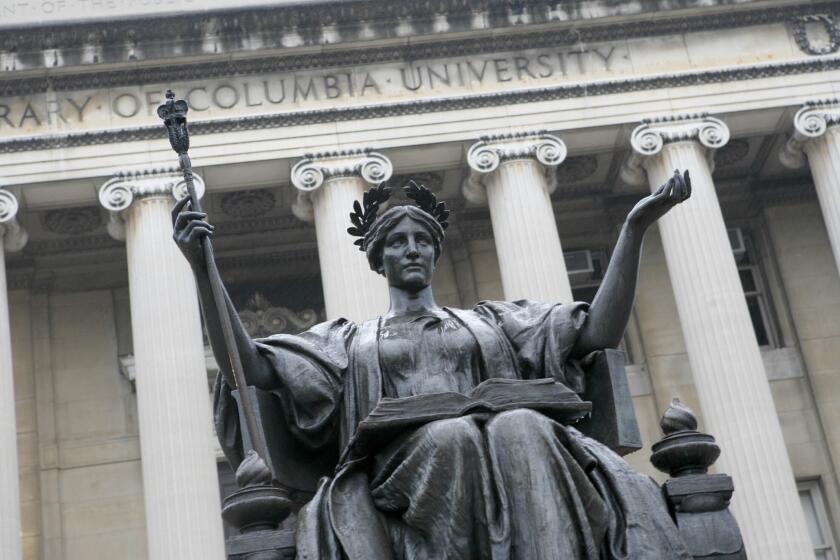7 things you need to know about how Trump’s budget would affect schools in California and nationwide
To U.S. Secretary of Education Betsy DeVos, the plan is “an historic investment in America’s students.”
To others, it is anything but.
Lily Eskelsen García, president of the National Education Assn., called it a “wrecking ball,” California Supt. of Public Instruction Tom Torlakson said “it fails,” and Obama administration Education Secretary John B. King Jr. called it “an assault on the American dream.”
Here’s what you need to know about how the proposal would affect schools and students in California and nationwide.
1. There would be deep cuts overall, for both K-12 and higher education
The $9.2 billion in cuts represent a 13.5% drop from the U.S. Department of Education’s 2017 budget of $68.2 billion. It includes a $2-million cut to the Office for Civil Rights, the group responsible for enforcing civil rights law in the nation’s schools.
Observers don’t expect Congress to pass the budget in its current form, but King, who now leads the Education Trust, a Washington-based nonprofit focused on educational equity, said it shows the administration’s values and frames the conversation around cuts instead of investments.
The administration is creating a committee to overhaul the Education Department. Its members are expected to submit a draft plan by the end of June that would propose “areas for workforce reduction.”
2. It would use part of a funding stream for disadvantaged kids to pay for school choice
The federal program known as Title I pays for services for low-income students. The Trump administration is proposing to use $1 billion in Title I money to pay for a new school-choice program. The $550-million increase in Title I that a recent budget deal gave states would be cut from their shares of the regularly scheduled funding formula moving forward. California got $1.74 billion from this program for the current school year.
Changes in the biggest federal school funding stream for poor students
Currently
- States get the money without specific conditions beyond those written into the Every Student Succeeds Act.
- L.A. Unified is preparing to build an open enrollment portal, but the current plan would not include any independent charter schools.
3. It would turn an innovation competition into a school voucher incentive
The Obama administration used a program called Investing in Innovation to help states experiment with new ideas in education. The budget proposal would beef up that program by $250 million, but the newer version would encourage states to use the funding to create or expand school voucher programs.
California twice voted down school voucher proposals. “I don’t see this happening in California,” said
Federal funding for charter schools would increase by $167 million. The Los Angeles Unified School District already has more charter schools than any other school district in the country.
4. College students on balance would get less help in paying for school
The budget would consolidate multiple programs for student loan forgiveness into one program, which would cap repayment at 12.5% of graduates’ income and forgive balances from undergraduate loans after 15 years.
The proposal would eliminate the Public Service Loan Forgiveness program — but currently enrolled students would not be affected. It would end federally subsidized student loans, meaning that college students would have to pay interest on the money they borrowed from the federal government, even while in school.
Students would be able to access Pell grants for classes they take during summer semesters.

5. It would eliminate a slew of programs
The budget would get rid of a $190-million literacy program, a $2.3-billion program meant to enrich instruction and the $1.2-billion 21st Century Community Learning Center program, which provides after-school options for students at disadvantaged schools. It also cuts Special Olympics education programs, a move an administration official called a tough but necessary trade-off.
The administration justifies these cuts by saying that these programs are duplicative or show no evidence of success.
6. Indian reservation schools and military students could lose out
The budget would eliminate Impact Aid Support Payments for Federal Property, dollars the federal government gives directly to school districts that don’t generate property taxes, including those that serve students on Indian reservations or public schools on untaxed federal land such as military bases. In California, about 15 school districts could be affected.
7. Cuts to other agencies would affect kids, too
Low-income students and their families depend on the federal government for help accessing healthcare, food and shelter. The budget would cut $193 billion in food stamp dollars. It would also slash $800 billion in funding for such programs as Children’s Health Insurance, Medicare and Obamacare.
Start your day right
Sign up for Essential California for news, features and recommendations from the L.A. Times and beyond in your inbox six days a week.
You may occasionally receive promotional content from the Los Angeles Times.




